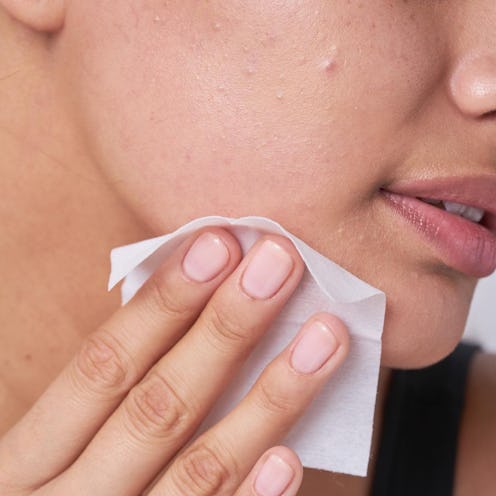(Skin)
The Dermatologist-Approved Ingredient You Should Always Recruit To Clear Hormonal Acne
It’s a non-negotiable.

You’d be hard pressed to find someone that has never experienced a breakout, whitehead, or blackhead. In fact, about 50% of women aged 20 to 29 and about 25% of women aged 40 to 49 experience hormonal acne, or acne that is caused by flare ups in hormones, according to Daisy Jing, founder of acne brand, Banish.
“The fluctuation of hormones can cause sebum or oil production to go into overdrive, therefore causing cystic acne,” says Jing. Dr. Corey L. Hartman, board-certified dermatologist and founder of Skin Wellness Dermatology, agrees. “The increased sebum either clogs pores or mixes with acne bacteria, leading to an increase in acne — often on the face.”
Regardless of your age, hormonal acne can become a chore if you don’t have the right acne-fighting skin care routine and products to combat cystic breakouts around the chin, cheeks, and jawline. Because the acne is caused by trapped oil, bacteria, and dead skin cells, products that prevent clogged pores stand up best to hormonal acne.
Ahead, TZR enlisted five of the best dermatologists to explain why hormonal acne happens, ways to treat it, and products to have on hand to prevent it.
What Is Hormonal Acne?
“Hormonal changes in the body typically play some role in stimulating the oil-producing structures of the skin that lead to acne — all acne has some hormonal component,” says Dr. Carlos Charles, board-certified dermatologist and co-founder of 4.5.6 Skin. However, there are specific hormones (testosterone and androgens) that can increase production of oil in the skin.
For instance, it’s common to experience hormonal acne during your menstrual period. “We have higher levels of androgens and estrogens during the follicular phase and periovulation causes increased sebum production, resulting in higher levels of skin lipids and subsequent increase in skin microflora that leads to breakouts,” says Dr. Loretta Ciraldo MD FAAD, a Miami-based board certified derm and founder of Dr. Loretta Skincare.
You might notice some bleeding, scarring, pain, and hyperpigmentation when it comes to these types of breakouts. “Because of the deep inflammation associated with these pimples, in melanin-rich skin they can often leave stubborn hyperpigmentation once they resolve, or reddish blotches that may take weeks to resolve in lighter skin tones,” says Dr. Charles.
How To Prevent & Treat Hormonal Acne
So how do you treat hormonal acne, and better yet, how can you prevent it? It’s a good rule of thumb to wash your face every morning and evening and to hydrate your skin with a moisturizer. “If your skin is dry, that can also cause an increase in sebum production in an effort for the skin to hydrate itself,” says Dr. Hartman. Fortunately, there are several effective ways to treat hormonal acne.
Spironolactone
All the experts interviewed for this story recommend Spironolactone, a diuretic pill, to assist with hormonal acne. “It helps block the receptors that bind certain forms of testosterone and other androgens, thereby minimizing undesired effects of these hormones, such as cystic acne,” Dr Charles says.
Isotretinoin
Isotretinoin, also known as Accutane, is a vitamin A-based drug that has several beneficial effects in the treatment of hormonal acne. “Isotretinoin can change the way the skin responds to hormonal fluctuations by decreasing the overall activity of the oil-producing sebaceous glands, thereby diminishing this form of acne,” Dr. Charles tells TZR.
Skin Care Acids
Incorporating acids into your evening routine could be the difference between a breakout and acne-free skin. The most common acid in skin care is glycolic acid. This acid dissolves the upper layer of skin cells and “can clear up clogged skin cells and prevent further hormonal acne if used consistently,” says Jing.
Salicylic acid is another great acid that will exfoliate the top layer of the skin, while penetrating into the pores to dissolve sebum. Dr. Ciraldo recommends investing in a product (typically a cleanser) with 2% salicylic, and to use it twice a day. “Salicylic, classified as a BHA [beta-hydroxy acid], is very good at ungluing dead cells from each other and penetrates well into pores to unclog them, to release stored up, unhealthy oils and bacteria,” she says.
Retinoids
Retinoids are vitamin A-based products that reduce the blockage of pores — preventing acne from forming. “They can help regulate cell turnover, decrease keratin buildup in pores that lead to clogging, and control oil production,” says Dr. Hartman. If you’re a first-time user, there are side-effects, though. It’s common for skin irritation and redness to occur so if you are opting for this route make sure your treatment plan builds up to this.
Are There Any Side Effects To Treatment?
“Like with any new treatment, when you start a new topical acne product, start off slow and follow the instructions on the label or one provided by your doctor (for prescription treatments),” says Dr. Hartman. “You may see some increased dryness or redness on the skin, so make sure to moisturize your skin, and always use sunscreen — especially since some acne medications can make skin extra sensitive to UV light.”
Fundamentally, all acne is hormonal. However, the below six dermatologist-approved products can correct your current routine to prevent it and keep hormonal breakouts at bay.
We only include products that have been independently selected by TZR's editorial team. However, we may receive a portion of sales if you purchase a product through a link in this article.
This article was originally published on